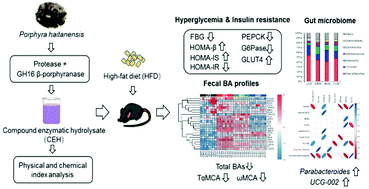The compound enzymatic hydrolysate of Neoporphyra haitanensis improved hyperglycemia and regulated the gut microbiome in high-fat diet-fed mice†
Abstract
We previously found that the combination of protease and a novel β-porphyranase Por16A_Wf may contribute to the deep-processing of laver. The purpose of the present study is to assess the hypoglycemic effect of the compound enzymatic hydrolysate (CEH) of Neoporphyra haitanensis. Thus, biochemical indexes related to diet-induced hyperglycemia were mainly detected using hematoxylin and eosin (H&E) staining, fluorescence quantitative PCR, and ultrahigh performance liquid chromatography-mass spectrometry (UPLC-MS). Then 16s rRNA gene sequencing was performed to analyze the effects of CEH on the gut microbiome in high-fat diet (HFD)-fed mice. The results suggested that CEH reduced the blood glucose level and alleviated insulin resistance. Possibly because CEH repressed intestinal α-glucosidase activity, inhibiting key enzymes (G6Pase and PEPCK) related to hepatic gluconeogenesis, and increased the expression of the enzyme (GLUT4) involved in peripheral glucose uptake. As potential indicators of hyperglycemia, total bile acids in the feces were reversed to the control levels after CEH intervention. Particularly, CEH decreased the content of tauro-α-muricholic acid (TαMCA) and ω-muricholic acid (ωMCA). Furthermore, CEH promoted the proliferation of beneficial bacteria (e.g. Parabacteroides), which may play a role in glycemic control. CEH also regulated the KEGG pathways associated with glycometabolism, such as “fructose and mannose metabolism”. In summary, CEH supplementation has favorable effects on improving glucose metabolism and regulating the gut microbiome in HFD-fed mice. CEH has potential to be applied in the development of functional foods.



 Please wait while we load your content...
Please wait while we load your content...